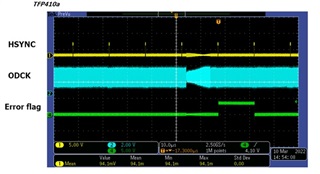Other Parts Discussed in Thread: TFP401A
Dear TI-er.
My customer have a problem.
When the TFP410 of the TX stage reaches a specific temperature, the following phenomenon is observed in the RX stage.
PCB1(FPGA –> TFP410) ---> HDMI Cable ---> PCB2(TFP401A –> FPGA –> USB)

Do you recommand the solution ? (PLL Power, layout ?)

